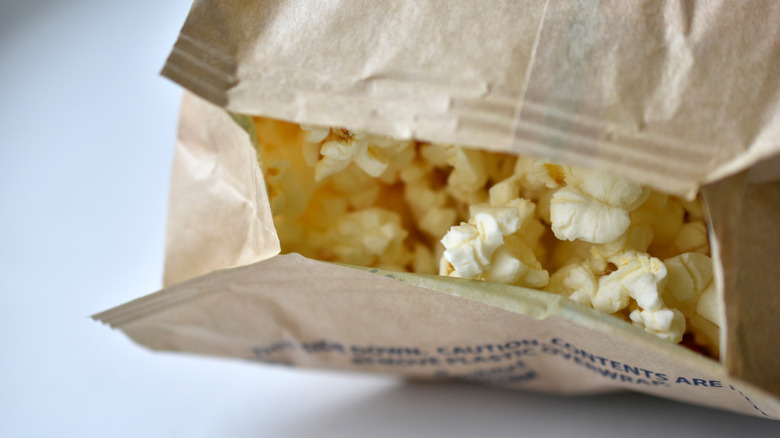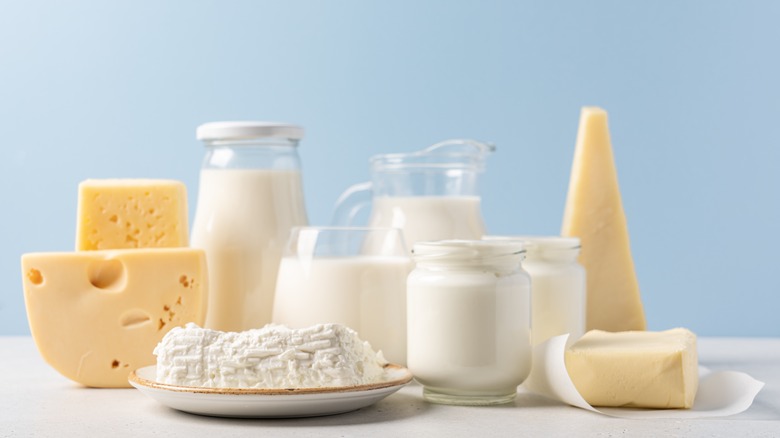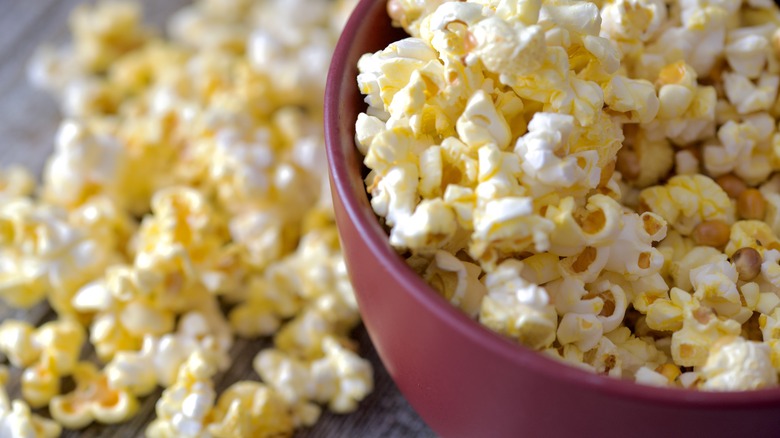The Toxic Ingredient That Changed The Microwave Popcorn Industry
Buttered popcorn can be found in countless households across America, being a must-have for movie nights, but its most controversial ingredient once caused a full-blown health crisis. Until 2007, many microwave popcorn brands included diacetyl in their recipes as a means of adding a buttery flavor, but this chemical posed far greater problems than greasy hands from eating popcorn.
Scarily, workers at microwave popcorn plants began reporting negative effects on their respiratory health around 2000, with some falling so ill that they required lung transplants. Studies later showed that the vapors given off by diacetyl were causing serious respiratory tract damage and obstruction, giving workers a condition called obliterative bronchiolitis. This illness became colloquially known as "popcorn lung."
By 2004, the National Institute for Occupational Safety & Health (NIOSH) released guidelines for working with diacetyl, including recommendations for respirator use, increased ventilation in workspaces, routine breathing tests, and limits for exposure. Although government agencies like the NIOSH, Centers for Disease Control and Prevention (CDC), and Food and Drug Administration (FDA) still allow diacetyl to be used in food items in the U.S., most big-name popcorn companies — including Orville Redenbacher, Act II, and Jiffy Pop – removed the ingredient from their products, in an effort to minimize potential lawsuits from employees.
Yes, diacetyl is still used in American foods
Instead of ruling diacetyl unsafe for consumption, the FDA declared it as "generally recognized as safe," so long as it is added to foods limited amounts. In turn, diacetyl is still added to countless food items, such as candy, gelatin, ice cream, and even e-cigarettes. More surprisingly, diacetyl occurs naturally in foods such as sour cream, beer, coffee, cheese, butter, and wine (think about how a Chardonnay is often described as "buttery"). Though mainly used as a flavor additive, diacetyl can be added as a preservative, particularly in unsalted types of butter.
If you're wondering why we don't get sick from consuming coffee and butter, it's because inhaling high concentrations of diacetyl in the air is what causes "popcorn lung." Working with large amounts of artificial diacetyl is the most risky. Diacetyl itself is not so harmful to consume, so long as the food containing it hasn't been heated — or if it has, the food has completely cooled. After all, it's diacetyl's vapors in the air that find their way into our lungs and potentially wreak havoc. This is why inhaling diacetyl via e-cigarettes can be dangerous.
Interestingly, diacetyl may not show up on food labels in the way we might expect, likely due to the ingredient's poor reputation. Rather, diacetyl may be listed as "DATEM" or simply lumped in with "natural/artificial flavorings." You may not even know it's in your food.
What's replacing diacetyl in popcorn and other foods?
Obviously, popcorn manufacturers and the rest of the food industry didn't stop using artificial butter flavorings in 2007, nor did they stop using diacetyl. However, many companies chose to seek out alternative ingredients that would prove less dangerous to workers and less scary to consumers. Chemicals like acetoin, 2,3-pentanedione, 2,3-hexanedione, and 2,3-heptanedione were found to be structurally similar enough that they could replace diacetyl.
As recently as 2012 and 2016, further research shared by the NIOSH showed 2,3-pentanedione to be just as potentially harmful as diacetyl, though it was noted that acetoin is a "considerably less hazardous" alternative. Government agencies still recommend that workers limit their exposure to these chemicals, but the fact remains that diacetyl and 2,3-pentanedione are still widely used in American products. Granted, the vapors produced by these chemicals are unlikely to be inhaled by consumers in quantities large enough to cause serious damage, but it's still scary to know the possibility exists.



